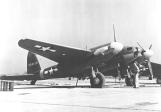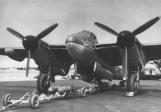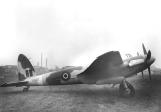1
The most famous Downsview-built Mosquito was undoubtedly The "Spook", USAAF F-8 no. 334926. According to de Havilland Canada records, "Spook" was originally KB 315, an early B. Mark VII model, and the third delivered to the USAAF. Its crew, pilot Major James Setchell and navigator Captain Jerome C. Alexander, successfully ferried "Spook" over the North Atlantic route and down to North Africa. Along with another F-8, "Faintin' Floozie III", piloted by Lt. Col. Karl "Pops" Polifca, it was delivered to the 32nd Squadron, 5th Pursuit Group, 12th Air Force, Mediterranean Theater of Operations, at Oran, Algeria, joining Lockheed F-4 Lightnings and RAF Mosquitos in the photo reconnaissance role.The "Spook" was employed in photographing potential targets, troop movements, supply lines, enemy bases, etc., in Tunisia, and then later in Sicily and Italy. Setchell was awarded the DFC for flying through intense flak to complete his mission on Jan. 16 and 17, 1944. Eventually, Setchell was shot down behind enemy lines in Italy while flying an F-4 Lightning and was captured. After several months, Setchell managed to escape and walk back to friendly territory.
The F-8s normally carried extra fuel tanks in the bomb bay, and had Fairchild K-17 or K.-22 cameras mounted in the nose and rear fuselage.
13
While about 350 Canadian Mosquitos had been delivered to the RAF before VE Day, the British penchant for secrecy resulted in the release of no information to the public concerning this significant contribution to the Allied war effort at the time. Also, most Mosquito bomber operations took place at night, so the photographic record is poor indeed.However, we do know now that many B. XXs and B. 25s took part in the huge blitz on Berlin in the closing months of the war, during which the German capital was attacked on 36 consecutive nights by the Light Night Striking Force. Canadian Mosquitos were often used as target markers for the elite Path Finder Force of Bomber Command, sometimes with the aid of H2S radar. Wing Commander Guy Gibson (VC, DSO, and DFC) of 627 Sqn., made his last flight in B. XX KB 267 on Sept. 19, 1944. He had been Master Bomber for a Lancaster raid on a factory at Rheydt, but crashed and was killed at Steenbergen, Holland, on the way back. Nos. 142 and 163 Sqns. from Wyton, were all Mosquito B. 25 units, while Nos. 128, 139, 162, 608, and 627 had B. XXs and B. 25s.
The first Canadian Mosquito raid on Berlin took place on Dec. 2, 1943. Canadian pilot G.W. Salter of 139 Sqn. flew B. XX KB 161 "Vancouver" on the mission.











